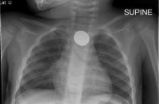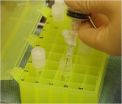(Press-News.org) Paediatric brain tumours preserve specific characteristics of the normal cells from which they originate – a previously unknown circumstance with ramifications for how tumour cells respond to treatment. This has been shown by Uppsala researcher Fredrik Swartling together with colleagues in the U.S., Canada and England in a study that was published today in the distinguished journal Cancer Cell.
Every year, 80-90 children in Sweden are afflicted with brain tumours, a serious form of paediatric cancer. Today, three of four children who receive treatment survive.
The discovery improves the prospects for finding more effective treatments for forms of paediatric cancer that are currently very difficult to cure and has great significance for understanding how brain tumours arise. The next step is to carry out the clinical analyses necessary for developing drugs that target specific types of brain tumours.
Trials were carried out using immature cells, or stem cells, from such regions of the brain as the cerebellum, cerebrum and brain stem. The stem cells were then compared with tumour cells from more than 100 patients. Cellular origin showed itself to be at least as important a determinant of tumour malignancy as the genetic mutations underlying the transformation of normal cells to tumour cells. The point in time at which tumours arose was also of great relevance to the effectiveness of treatment.
"We can't focus exclusively on mutated genes when looking at cancer," says Fredrik Swartling, who directed the study jointly with paediatric neurologist William Weiss, who works at the University of California children's hospital and brain tumour research center in San Francisco, California, in the U.S. "The status of the cells of origin giving rise to cancer is at least as important from a treatment standpoint. Our study shows that tumours contain markers for these cells of origin."
Brain tumours most often arise on account of accidental genetic mutations. One gene that mutates readily and is well-represented in paediatric brain tumours is the MYCN cancer gene. Previous research has proposed that patients with high levels of a specific cancer gene like MYCN should be treated in the same way. The current study shows that this is not the case.
"The tumours are more diverse that we believed," Fredrik Swartling says. "It is very important, even for patients who exhibit the exact same mutation of a cancer gene, whether their tumours arose in the cerebellum, cerebrum or brain stem and whether these tumours arose during fetal stages or following birth."
The researchers showed in the study that normal stem cells are transformed into brain tumour cells in vitro following introduction of the MYCN cancer gene to the cells. Stem cells from an early fetal stage and from a later life juncture were both transformed into tumour cells. The effectiveness of treatment differed, despite the fact that the same cancer gene had caused the tumours in each case.
That tumours reflect their origins makes it relatively simple to determine the origin of the cancer represented in a tumour biopsy from a patient. The challenge ahead will be to identify reliable markers for tumour origin to enable better judgement about treatment options and ensure the effectiveness of treatment in diverse cases.
"The goal is to develop a range of different treatments for patients of different types," Fredrik Swartling says. "It may take some time before such treatments are available at hospitals, but clinical trials involving drugs similar to those used in the study are already under way, and we are keeping our fingers crossed that the drugs will work as anticipated."
###The study was financed by the Swedish Childhood Cancer Foundation, the Swedish Cancer Society and the Swedish Research Council, among other sources.
Children's brain tumors more diverse than previously believed
2012-05-15
ELSE PRESS RELEASES FROM THIS DATE:
Study finds number of battery-related emergency department visits by children more than doubles
2012-05-15
VIDEO:
In today's technology-driven world, batteries, especially button batteries, are everywhere. A new study shows that every 90 minutes a child younger than 18 years of age is seen in a...
Click here for more information.
In today's technology-driven world, batteries, especially button batteries, are everywhere. They power countless gadgets and electronic items that we use every day. While they may seem harmless, button batteries can be dangerous if swallowed by children. ...
Study examines injuries with baby bottles, pacifiers and sippy cups in the US
2012-05-15
VIDEO:
Sippy cups, bottles and pacifiers are popular items used by many parents for their kids. However, a new study shows that these items can be dangerous if a child is...
Click here for more information.
A new study by researchers in the Center for Biobehavioral Health and the Center for Injury Research and Policy at Nationwide Children's Hospital examined pediatric injuries associated with baby bottles, pacifiers and sippy cups. Researchers found that from 1991 to 2010, ...
Nearly one-tenth of hemisphere's mammals unlikely to outrun climate change
2012-05-15
A safe haven could be out of reach for 9 percent of the Western Hemisphere's mammals, and as much as 40 percent in certain regions, because the animals just won't move swiftly enough to outpace climate change.
For the past decade scientists have outlined new areas suitable for mammals likely to be displaced as climate change first makes their current habitat inhospitable, then unlivable. For the first time a new study considers whether mammals will actually be able to move to those new areas before they are overrun by climate change. Carrie Schloss, University of Washington ...
Scientists make breakthrough in bile duct cancer with discovery of new gene mutations
2012-05-15
Grand Rapids, Mich. (May 14, 2012) - A team of international scientists has made a significant breakthrough in understanding the cause of bile duct cancer, a deadly type of liver cancer. By identifying several new genes frequently mutated in bile duct cancers, researchers are paving the way for better understanding of how bile duct cancers develop. Their discovery is published online in Nature Genetics.
Bile Duct Cancer, or Cholangiocarcinoma, is a fatal cancer with a poor prognosis. Accounting for 10 to 25 per cent of all primary liver cancers worldwide, bile duct cancer ...
Great recession reflux amounts to more hunger among seniors
2012-05-15
URBANA – A new study that looked at the hunger trends over a 10-year period found that 14.85 percent of seniors in the United States, more than one in seven, face the threat of hunger. This translates into 8.3 million seniors.
"In 2005, we reported that one in nine seniors faced the threat of hunger," said Craig Gundersen, University of Illinois associate professor of agricultural and consumer economics and executive director of the National Soybean Research Laboratory who led the data analysis on the study. "So, unlike the population as a whole, food insecurity among ...
New York Stem Cell Foundation scientist grows bone from human embryonic stem cells
2012-05-15
NEW YORK, NY (May 14, 2012) -- Dr. Darja Marolt, an Investigator at The New York Stem Cell Foundation (NYSCF) Laboratory, is lead author on a study showing that human embryonic stem cells can be used to grow bone tissue grafts for use in research and potential therapeutic application. Dr. Marolt conducted this research as a post-doctoral NYSCF – Druckenmiller Fellow at Columbia University in the laboratory of Dr. Gordana Vunjak-Novakovic.
The study is the first example of using bone cell progenitors derived from human embryonic stem cells to grow compact bone tissue ...
Brain circuitry is different for women with anorexia and obesity
2012-05-15
AURORA, Colo. (May 14, 2012) - Why does one person become anorexic and another obese? A study recently published by a University of Colorado School of Medicine researcher shows that reward circuits in the brain are sensitized in anorexic women and desensitized in obese women. The findings also suggest that eating behavior is related to brain dopamine pathways involved in addictions.
Guido Frank, MD, assistant professor director of the Developmental Brain Research Program at the CU School of Medicine and his colleagues used functional magnetic resonance imaging (fMRI) ...
Growing risks from hatchery fish
2012-05-15
Portland, Oregon – May 14, 2012 -- A newly published collection of more than 20 studies by leading university scientists and government fishery researchers in Alaska, British Columbia, Washington, Oregon, California, Russia and Japan provides mounting evidence that salmon raised in man-made hatcheries can harm wild salmon through competition for food and habitat.
"The genetic effects of mixing hatchery fish with wild populations have been well-documented," says journal editor David Noakes from Oregon State University. "But until now the ecological effects were largely ...
Genetic test identifies eye cancer tumors likely to spread
2012-05-15
AUDIO:
The most common form of cancer in the eye can be deadly. New treatments have allowed doctors to preserve vision in patients with ocular melanoma, but sometimes the cancer...
Click here for more information.
Researchers at Washington University School of Medicine in St. Louis have developed a genetic test that can accurately predict whether the most common form of eye cancer will spread to other parts of the body, particularly the liver.
In 459 patients with ocular ...
Lawrence Livermore work may improve the efficiency of the biofuel production cycle
2012-05-15
By deciphering the makeup of a bacterium found in the soil of a tropical rain forest, scientists may have a better understanding of how to more efficiently produce biofuels.
The production of liquid fuels derived from plant biomass offers a promising technology for reducing greenhouse gas emissions and dependence on fossil fuels.
While sugars stored within the plant cell wall, known as lignocellulose, are plentiful enough to supply most energy needs on the planet, their extraction is difficult and requires chemical pretreatment followed by enzymatic digestion using ...



